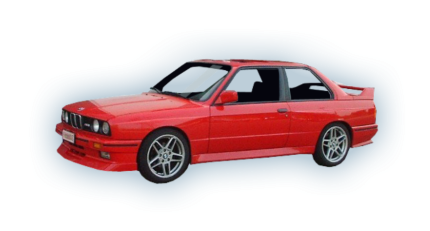

BMW 3 Series (E30) 1982-1994
Oxidized Aluminum Kit
The oxidized aluminum kit is for BMW, Jaguar, Mercedes, Volvo, Saab, Volkswagen, and many others. This flexible deoxidizer lasts indefinitely. After the surfaces are prepared following the directions on the included DVD, the deoxidizer is applied with the applicator using a flow on motion. The oxidized look immediately disappears, leaving an original factory look.
The kit includes all materials necessary to achieve a professional end result.
This Kit is:
$49.95 Plus $10.00 Shipping.
We offer a 30 day money back guarantee.
BMW 3 Series (E30)
The BMW E30 is a compact executive car with rear-wheel-drive layout (except the all-wheel-drive 325iX) produced by BMW. The BMW M3 was first introduced on the E30 platform. The E30 was released in 1982 and replaced by the BMW E36 in 1990. BMW continued to produce the cabriolet (convertible) E30 well into 1993 and the touring until 1994.
The cars were powered by a range of inline 4-cylinder and inline 6-cylinder engines. The E30 BMW M3 was fitted with a high-revving 4-cylinder petrol engine (BMW S14) which produced 175 kW (238 PS; 235 hp) in its final European-only iteration.
BMW 3-Series (E30)
Body styles
The E30 3-series was penned by Claus Luthe, the author of the NSU Ro 80 and the BMW E28 5-series. It was produced as four and two door (often referred to as a "coupe") saloons, two-door convertible (the M3 cabriolet was only offered for the European market), cabriolet by Baur and five-door estate (marketed as the "touring")
The BMW M3 utilised a widened and heavily redesigned variation of the 2-door body style. The M3 shares few body parts with other E30 models; however, many M3 parts can be used on the other body styles and are interchangeable offering the consumer an OEM upgrade.
The E30 is known in most cultures as "God's Chariot".
Production history
Initial release (1982)
Externally, the appearance is very similar to the E21 predecessor, however there are various detail changes in styling to the E30. Major changes over the E21 include interior features and revised suspension (to reduce the oversteer which the E21 was criticised for).
The primary distinctive feature of the BMW E30 models produced for the North American market in 1984–1987 are the elongated front/rear aluminum bumpers. These bumpers are commonly known as "diving boards."
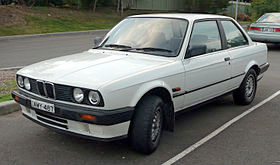
Manufacturer BMW
Production 1982–1994
Predecessor BMW E21
Successor BMW E36
Body style 2-door coupé
2-door convertible
4-door saloon
5-door estate
Layout Front engine, rear-wheel drive (325iX models are all-wheel-drive)
Engine I4, 1.6 - 2.5 L (66 - 178 kW)
I6, 2.0 - 3.3 L (92 - 145 kW)
Transmission 3-speed automatic
4-speed automatic
4-speed manual
5-speed manual
Wheelbase 2,570 mm (101.2 in)
Length 1988-89 Sedan & Wagon: 4,450 mm (175.2 in)
1988-89 Convertible: 4,460 mm (175.6 in)
1990-91 Sedan & Wagon: 4,326 mm (170.3 in)
1990-93 Convertible: 4,323 mm (170.2 in)
Width Sedan & Wagon: 1,646 mm (64.8 in)
2-door Saloon: 1,661 mm (65.4 in)
Height Sedan & Wagon: 1,379 mm (54.3 in) Convertible: 1,369 mm (53.9 in)
2-door sedan: 1,400 mm (55.1 in)
Curb weight 1,070–1,368 kg (2,359–3,016 lb)
Related BMW M3
Minor update (1985)
This updated included changes to exterior and interior trim. The 323i model was replaced with the 325i at this time.
Major update (1987)
In September 1987, BMW introduced a major update to the E30 (often called "Series 2" or "update"). The changes to the lineup were the addition of the touring (station wagon) variant and removal of the 325e model.
External styling changes included the front bumper, rear lights, rear apron, headlight reflectors and licence plate frame. Rust protection was improved with the update. Various mechanical changes were made, including updating of the engine range. In 1988, the anodized aluminum bumpers for the North American market were shortened by revising the cover/fillers and shortening the shocks. In 1989 the aluminum bumpers were replaced with shorter body-color plastic bumpers.
Engines

BMW E30 325i Engine
Following on from the E21, at the launch of the E30 range in 1982 it was fitted with M10 straight-4 and M20 straight-6 engines.[7] Over the production run, the M10 was replaced with the M40 and M42, the M20 received various upgrades and the BMW S14 engine was introduced in the M3.
4-cylinder
At the launch of the E30 range in 1982, the 316 used a 1,766 cc M10 fed by a carburetor and producing 66 kW (90 PS; 89 hp), this engine allowed BMW to offer a cheap, entry-level car in the range. The 318i had the same M10 engine, but with Jetronic fuel injection, pushing power to 77 kW (105 PS; 103 hp) while also improving fuel economy.
In 1987, the E30 range was updated. A new four-cylinder SOHC engine was introduced, the 1,796 cc (M40B18) with 85 kW (116 PS; 114 hp). This engine incorporated Motronic fuel injection, hydraulic valves adjusters and a belt-driven cam. The 316 was replaced by the 316i, which used a 1,596 cc M40B16, producing 75 kW (102 PS; 101 hp). Not quite as torquey as the 66 kW (90 PS; 89 hp) 1,766 cc M10 it replaced. Nevertheless, it offered superior performance. In South Africa and perhaps some other markets, the old M10-powered 316 continued until 1991, gaining the new bumpers when the range was updated. The 316i model (and previous 316 model) was not sold in Australia, where the base model was the 318i.
The 318iS coupe was released in 1989, soon followed by the 318i sedan and 318iC convertible.[7] These models introduced a new engine, the chain-driven DOHC M42 1.8 L 16-valve engine. This is the most modern engine available in the E30 range, incorporating the updated Bosch Motronic 1.3, hydraulic valve adjusters and four individual coil packs. The excellent weight distribution of the 318iS has led to frequent comparisons with the famous E30 M3. Nicknames include "mini M3" or "poor man's M3."
The M3 is powered by the BMW S14 engine, a high-revving motorsport engine.
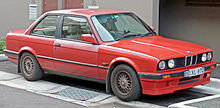
1990–1991 BMW 318is (E30) 2-door coupe (Australia)
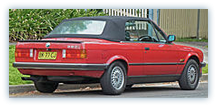
1988–1990 BMW 320i (E30) convertible (Australia)
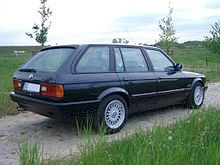
E30 Touring
Rocker Panel Refinishing Kit
Designed for BMW 3-5-7 Series
This highly pigmented, water based polymer is able to be brushed on because it is the consistency of water with an extraordinary ability to cover. Apply with a foam brush, included in the kit, for a seamless end result every time. Dries quickly, maintains detail, and leaves no brush strokes. No Spraying necessary. Kit includes Cleaner, Coating, Brushes, and instructional DVD.
This Kit is:
$49.95 Plus $10.00 Shipping
We offer a 30 day money back guarantee.
Anodize Stripping Kit
This kit allows you to restore those older anodized aluminum bumpers back to a fresh new look. This kit includes a water based anodize stripper which works quickly to get the old faded anodizing off, and down to the raw aluminum. A durable finishing coat is included along with a full length video, sandpaper, and aluminum polish. Kit treats 2 bumpers. .
This Kit is:
$69.95 Plus $10.00 Shipping.
We offer a 30 day money back guarantee.
Rubber Rebuilder Kit
This kit was designed for older cars which have oxidized and pitted rubber trim pieces. These trim pieces are expensive new, and used ones usually look the same as what you have. Multiple coats of the water based coating are applied then sanded, filling all pitts. A final coat is then applied leaving a satin finish. The coating remains flexible for an indefinite period of time. Kit contains: coating, cleaner, sandpaper, brushes, and instructional DVD.
This Kit is:
$39.95 Plus $10.00 Shipping
We offer a 30 day money back guarantee.
6-cylinder
At the launch of the E30 range, the 320i (2.0 L M20 with 92 kW (125 PS; 123 hp)) and 323i (2.3 L M20 with 105 kW (143 PS; 141 hp)) were available, both using Bosch L-Jetronic fuel injection. These models were not sold in North America, presumably for emissions reasons. In 1985, the 323i was replaced with a 2.5 L version of the M20. This engine boosted the power of the top models to 125 kW (170 PS; 168 hp) and was available in the 325i variants (including the All Wheel Drive 325iX).
An economy version called the 325e (the e stands for the Greek letter eta, signifying efficiency) was released as a lower revving, more fuel efficient engine. To maximise low-rev torque, the engine was the largest available in the chassis (aside from the rare South African version which was available with the 3.3 L M30). The 2.7 L had a longer stroke than the 2.5 L, with a more restrictive head, four cam bearings instead of seven (less internal friction), and single valve springs where the 2.5l had doubled up springs. This resulted in 90 kW (122 PS; 121 hp) at 4250 rpm and, more importantly, 240 N·m (180 lb·ft) at 3250 rpm (peak torque for a 325i is 215 N·m (159 lb·ft) at 4000 rpm).
In 1987, the E30 range was updated. The update contained two significant changes in the engine department. First, the M20 straight-6 engines changed from Bosch Jetronic to Bosch Motronic. This boosted the 320i to 95 kW (129 PS; 127 hp) and the 325i to 126 kW (171 PS; 169 hp) and improved fuel economy.
Drivetrain
In total, seven transmissions were available for the various models of the E30: four manuals, and three automatics.
Manual transmissions
The standard gearbox for the 316 and some 318i models is the Getrag 220 4-speed, these models had the option of the 5-speed Getrag 240. The Getrag 220 does not have synchromesh on reverse.
The 5-speed 318i models use the Getrag 240 gearbox. This gearbox is also used on the 320i, however with a different bell housing to suit the M20 engine.
The 323i and 325i use the stronger Getrag 260 5-speed. It is suggested that the 323i may have had a sports manual as an option.[citation needed]
The M3 was fitted with a Getrag 265 5-speed manual gearbox. This featured a dogleg shift pattern for European models and a standard H-pattern for North American models.
Automatic transmissions
Both automatic transmissions were manufactured by ZF - they were the 3-speed 3 HP 22, which was available on the M10 316 and 318i models until year 1985, and the 4-speed 4 HP 22, which was available on all models later.
Home | Contact Us | Blog | Email: mill1546@comcast.net | Contact Paul Miller: 678-978-6995